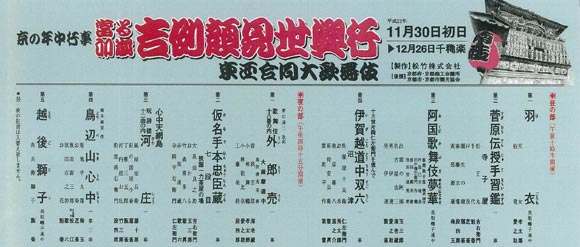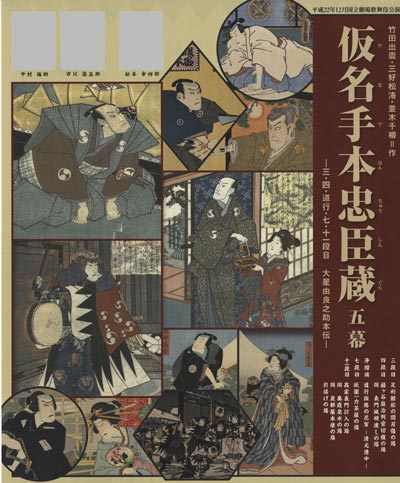| Comments |
Hagoromo: the legend of the angel who came to earth to bathe and then had her
heavenly feathered robe stolen by a fisherman is famous in all forms of Japanese
theater. This month features an elegant dance version of the story with
Kataoka Ainosuke as the fisherman and Kataoka Takatar˘ as the angel.
Terakoya: Genz˘ and his wife Tonami run a small school and are
protecting Kan Sh˘j˘'s son and heir, saying that he is their son. However,
word has gotten out Kan Sh˘j˘'s son is there and Genz˘ has been ordered to
behead him. Moreover, Matsu˘maru is to come to inspect the head. Their only
alternative is to kill one of the other students as a substitute, but all of
the students are farmer's children who could never pass for the son of a court
aristocrat. However, a new boy arrives that day and Genz˘ makes the terrible
decision to kill him in the place of his lord. As it turns out, Matsu˘maru has
sent his own son to be sacrificed, because of his family's long loyalty to
Kan Sh˘j˘. But he must face the most terrible situation for a father,
inspecting the head of his own son and lying when he says that it is the
genuine head of the son of Kan Sh˘j˘. Finally Matsu˘maru reveals his true
feelings to Genz˘ and he and his wife Chiyo mourn their dead son.
Starring Nakamura Kichiemon as Matsu˘maru, Nakamura Baigyoku as Genz˘, Nakamura Kaishun as Chiyo and Nakamura Shibajaku as Tonami.
Featuring also Ichikawa Danshir˘, Nakamura Senjaku and Nakamura Tanetar˘.
Okuni Kabuki: Kabuki began with a woman, with the dances of Izumo no Okuni,
who came to Ky˘to claiming that she was collecting funds for the Izumo shrine and whose lively dances and
colorful costumes became a hit. In time, this would become the origin of Kabuki dance, and in turn, Kabuki plays.
Little is known about Okuni, but there are some pictures and many legends, this month dramatized as a graceful
dance. Starring Band˘ Tamasabur˘ and Kataoka Nizaemon as Okuni and Nagoya Sanza. Featuring also Nakamura Kanjaku, Kataoka Ainosuke, Ichikawa Emiya,
Ichikawa Emisabur˘, Ichikawa Shun'en and Kamimura Kichiya.
Numazu: a dramatization of one of the most famous historical vendattas of the
Edo period. "Numazu" is one act that tells
of the sacrifices of those not directly involved in the vendetta itself but members
of the same family who are indebted to the two opposing sides.
The kimono merchant Jűbŕ (Kataoka Nizaemon) meets a porter Heisaku (Kataoka Gat˘)
as he travels west on business. They find that not only are they long-separated
father and son, but that they also lie on opposite sides of the vendetta.
Their loyalties prevent them from openly acknowledging their relationship.
Heisaku sacrifices his life to get information from his son essential to his
side's cause. Featuring Kataoka Hidetar˘ in the role of Heisaku's daughter Oyone.
Uir˘ Uri: there are many plays based on the revenge by the Soga brothers
on Kud˘ Suketsune, the man that arranged to have their father killed.
In this particular play, this dramatic fight is transformed into light fantasy
by showing one of the Soga brothers disguised as a peddler of uir˘, a medicine
that makes it possible to speak quickly and elegantly. The highlight of the
play is a long speech full of puns and wordplays. Starring Kataoka Ainosuke as the peddler.
Gion Ichiriki Jaya: "Chűshingura" is one of
the most popular plays in the theatre and shows a true event when forty-seven
masterless samurai avenged the death of their lord by killing his enemy.
The seventh act is one of the most popular and shows the leader of the vendetta
Yuranosuke as he is hiding his intention to avenge his lordĺs death by pretending
to be only interested in pleasure, but also encountering key figures on
his side and the side of the enemy. Yuranosuke (Nakamura Kichiemon)
spends his days and nights in the pleasure quarters of Ky˘to in an effort to
make their lordĺs enemy, Moron˘, believe he is not planning a vendetta.
His acting is so good that even men in his own group believe he has given his
life up to pleasure. Moron˘ is not so easily convinced, though, and has sent spies,
including a former retainer of their late lord, En'ya Hangan, to find Yuranosuke's
true intentions. Okaru (Band˘ Tamasabur˘), the wife of one of the retainers is now a
courtesan at the Ichiriki Teahouse, unaware that her husband is dead.
Okaru's brother Heiemon (Kataoka Nizaemon), a servant in the Hangan household,
has also come to the teahouse and the interaction of these characters
becomes a matter of life and death and ends with Yuranosuke preparing to
lead the vendetta.
Kawash˘: this late love suicide play by Chikamatsu Monzaemon
is considered by many to be his masterpiece. The paper seller Jihŕ (Sakata T˘jűr˘) is in love with
the courtesan Koharu (Nakamura Senjaku) and all those around them are afraid that they will commit
love suicide. Jihŕĺs wife Osan urgently pleads with Koharu to pretend that she does
not love Jihŕ any more, in order to save his life. In the first and most famous
scene in the Kawash˘ teahouse, Jihŕĺs brother Magoemon (Ichikawa Danshir˘) masquerades as a samurai
to find out Koharuĺs true feelings. Jihŕ listens in from the outside and is
astonished to hear her say that she does not want to commit love suicide.
In a rage, Jihŕ breaks off all relations with her, while Magoemon is moved to
learn that she has done this out of consideration for Osanĺs feelings.
This play is a classic example of the ďsaka style of acting.
Toribeyama Shinjű:
(The Love Suicides at Toribeyama)
This play by 20th century playwright Okamoto Kid˘ mixes old and new Kabuki styles.
The samurai Hankur˘ (Nakamura Baigyoku) is in love with the courtesan Osome (Nakamura Shibajaku).
Visiting her one night in the pleasure quarters of Ky˘to, he gets into a
drunken quarrel and ends up killing a man in a fight. Knowing that execution
awaits him, the two lovers decide to die together instead.
Hankur˘ and Osome travel the road to death in new kimono that ironically
were made for them to celebrate the New Year together.
Echigo Jishi: one of the most popular dances in the Kabuki repertory, this shows a traveling
entertainer (Nakamura Kanjaku) that performed lion dances, with an adult playing the music and a child doing acrobatics like
a little lion. The dance shows the feelings of the adult performer and his feelings for his home in the
Echigo region and finally ends with the famous white cloth of
the area as he waves long strips of cloth in a variety of different patterns.
Sources: Earphone Guide website
Sh˘chiku Kabuki Official Website for "Okuni Kabuki"
|




